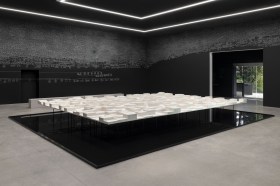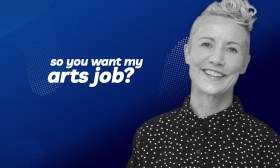A winning creative marketing image for Deloitte’s Green Dot campaign
I work in a business where creativity has not been traditionally valued – in fact ‘creative accounting’ and ‘being creative with the facts’ are clichéd bywords for criminality in accounting and consulting, a trait which doesn’t allow you to build an enduring brand.
We saw just over ten years ago Arthur Andersen, the biggest of the Big Five global accounting firms, collapse entirely within a year on the heels of its creative interpretation in the audit of Enron, an energy corporation based in Texas. Creativity has its place in business, and it is not on the balance sheet.
I work in the world’s largest and oldest accounting business, next year one hundred and seventy years young and operating in over one hundred and fifty countries: a thirty-two billion dollar, two hundred thousand person behemoth. In Australia, we’ve made a specialty of scotching preconceptions, with an internal mantra to innovate, embrace ambiguity and new territory, and to be different. Had Deloitte not welcomed the extraordinary spectrum of obsessive subject matter experts, professional misfits and maverick personalities in the fields of strategy, digital, economics, design thinking, leadership and people management that it has, it would not have been able to foment the uniquely productive creative tension that has seen it become a beacon for many like me. I’ll come back a little later to why that has provided a particularly fertile environment for creative thinking over the past decade; suffice to say that if I hadn’t personally been able to put to productive use my own compulsions in creative writing, musical composition, photography and design, I would not have been able to make a contribution to one of the more extraordinary turnarounds in contemporary Australian business, and nor would I be have been able to effectively lead what I consider Australia’s best marketing team.
I can predict with certainty that the value of good ideas will continue, inexorably, to rise. As we move into a world increasingly characterized by automation, commoditization, risk adversity, short term horizons and stifling, duplicate-in-quadruplicate bureaucracy, I will bet every one of you in this room that it will be the ideas which reframe accepted wisdoms, and cause a rethink about what is possible, that will be valued most highly of all by society, by government, and by business. Creativity will, in the future, be the most valued currency in business.
A 2010/2012 survey of 300 directors and executives on the role of creativity in businesses found that leaders look for competitive advantage, with 96% thinking that creativity is critical in determining business strategy. But 50% of those same directors and execs admitted that no-one in the business was responsible for it.
It’s a fascinating disconnect. We spend so much time talking about and valuing the importance of technology, of big data and systems, but in the end, the most valuable point of differentiation and the greatest prize, is creativity – because it can’t be bottled or replicated. You can’t make someone creative. There’s much we can do to rationalize it, but in the end great creativity can’t be quantified, even if it can be seen and understood and felt. Telling an old story in an original way will always reward you – but creating an entirely new story is the gold standard in the currency of ideas.
It was for that reason that at Deloitte several years ago, we embraced social media – and in particular, the internal micro-blogging platform Yammer – so wholeheartedly. Around 2007, as Facebook, Twitter, YouTube and other platforms started really penetrating the business space, and many corporates scrambled to figure out their position on the new media, we decided to embrace it. Our philosophy was that it was coming down the highway, was going to change the way people connected, and we would have to deal with it one way or another; so why not look for ways of using it to our advantage, and accruing social capital within our community?
The idea was to create a culture of participation, flatten the hierarchy of traditional business, and blur the boundaries between worktime and personal passions on a platform hosting a digital water cooler conversation for several thousand people.
One of the first things we did was run a design competition, asking our people to design a t-shirt using our Green Dot to describe our strategy and culture, but without using our corporate name. Nobody, even a sad Deloitte tragic like me, wants to wear a t-shirt or cap to the beach on the weekend looking like a corporate advertisement – it’s just not cool – but we figured that by inviting our several thousand people to collaborate to create well designed, humorous motifs and then vote between themselves for the winners they’d like to wear, they would wear them. We got over 700 designs from across the firm – ranging from beautifully produced electronic artwork, to hand-drawn motifs on crumpled pieces of paper. The ten final designs were selected democratically by our extended creative team of 5000 people, and the results were so popular that we gave away over 10,000 t-shirts, as our people wanted them for their partners, their children and their friends.
It taught me an important lesson about how marketing is changing and where it is going. It is no longer the preserve of the creative department to come up with the big idea and foist it upon a waiting internal or external audience. The ones perhaps best able to articulate the idea are the ones who live it in the market every day, rather than the ones who are paid to create.
The best ideas, it turns out, are out there in the crowd, and they span the whole range of experience and represent both the centre and the edge: the organization’s philosophical, political and cultural centre of gravity, and its outlying conservative or progressive borders. If you can harness that collective sentiment, and create a culture of participation where every member of the business feels like they have a stake in your culture and are valued for their contribution, then you’re creating a powerful new business force – one that plays at the edge of what is possible in business, and of what is becoming increasingly probable as the dominant business model of the future.
My friend Pete Williams – one of Deloitte’s maverick accountants, and now CEO of the Centre for the Edge in Australia, has done brilliant things with crowd-sourcing and social media, including mobilising a community to drive the reconstruction of Flowerdale after the Victorian 2009 fires.
Pete’s creative capability, as with all those in business playing at the digital edge, is to pull a business out of its comfort zone and forward into new space. As an unreconstructed, in-your-face radical thinker and agitator, he wears it wall. My role as a creative, meanwhile, lies at the centre, a guerilla behind the lines, disguised at times like the civilian population which I have to infiltrate so as to win the trust of those around me, while gently, through a creative blend of emotion and logic, encouraging forward momentum. To do my job effectively, I can never lose touch with the edge; so I keep my communication lines open, maintain contact with the outliers, absorb their ideas and learnings, and translate them into language spoken more commonly at the conservative centre of the organization. To me, it is a choice, not an inevitability, to do it this way – and I think the success of Deloitte, in overturning preconceptions about how a big business should act, is evidence that you can keep people at the apex of your business model, have fun, do good things and make money.
I’ve had a lot of very high points in a career spanning several countries and a range of very different industries, but I’ve never enjoyed myself quite so much as these past 12 years, in a firm that continues to embrace ambiguity and the future, and is always open to blending creative disciplines. And 12 is as good a number as any to close on, as I share 12 key ideas from my book of corporate bohemian traveller’s tales.
They are that:
- The currency of ideas is your most certain, bankable bet for the future
- Art has the power to ferret out the truth
- To master your doubts as a creative in business, it’s worth recognising that every business is waiting for the next, best idea
- That the digital and global age embraces the realism of mutual self interest
- Creativity in business will always generate an important tension by playing at the intersection of authenticity and commercialism,
- Product improvement can be making better widgets; it can also be the inspiring, equipping and motivation of people to deliver their smarts with energy and authenticity
- Emergent business models increasingly require equal employment of left and right brain thinking
- Leaders look for critical advantage and are increasingly aware that creativity is critical in determining business strategy
- The most valuable point of differentiation is creativity, because it can’t be bottled or replicated
- If you can create a culture of participation, then you can create a force that plays at the edge of what is possible in business.
- Most businesses say their most important asset is their people. Most business then ignore this truth. When you put people at the apex of your business model, you can have fun, do good things and make money.
- That creativity drives business success – an axiom of which I hope I have persuaded you.





